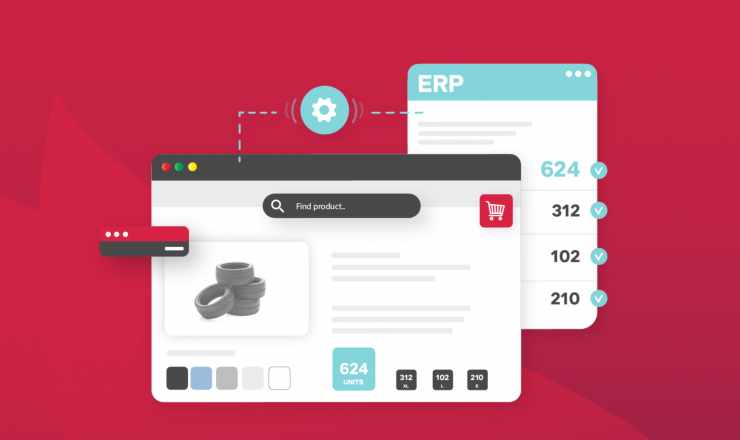

Unless you’re ecstatic at the idea of manually tracking every single inventory item, delivery, project, timeline, paystub, and timesheet; you’re going to need a software system to automate and connect all these different processes. Manufacturing ERP systems can be that solution.
Manufacturing ERP systems are a type of software that tracks and automates traditional business operations (think accounting and payroll) along with manufacturing processes (supply chain, production, warehouse management) under one roof.
But is your business ready for a robust, manufacturing ERP system? Are there any alternatives that you should consider first?
I promise I’ll answer all these questions (and more!) in our manufacturing ERP system buyer’s guide.
Let’s jump in!
What is a manufacturing ERP system?
A manufacturing ERP system is a specific subset of ERP software. ERP stands for Enterprise Resource Planning, and refers to a software system that unifies both back-of-office business systems like finance, accounting, HR, and payroll as well as production systems like inventory management.
Manufacturing ERP systems refer to industry-specific ERPs; ERPs that were developed to help with manufacturing, as opposed to simply having some useful/beneficial manufacturing add-ons.
How is an ERP different than an MRP?
ERPs actually evolved from MRPs. MRP stands for Material Requirements Planning, and refers to a type of software that was originally developed back in the 1950s, but really took off around the mid 1970s.
MRP software focuses on three things: production planning, scheduling, and inventory control. Think of MRP as a software that focuses on the materials needed for manufacturing. With an MRP, you can optimize your inventory, coordinate production, and plan deliveries.
ERP systems evolved from MRPs. The ERP takes all of the MRP systems and combines them with traditional, back-of-office systems like payroll, accounting, and finance.
The end result of an ERP is a unified database that gives all users a single platform with accurate, real-time data from every department within a company.
ERPs provide robust integration, superior data insights, and they reduce system siloes and data inaccuracies.

The new normal for B2B buying has arrived.
Is your business ready?
Why should I consider a manufacturing ERP system?
Every business is different, and the reasons for needing a manufacturing ERP system will vary from firm to firm.
But, the main reason that most businesses should consider adopting a manufacturing ERP is due to its power of data unity. ERPs unite traditionally separate systems like payroll, inventory, shipping, and finance under a single platform. When all of your data is housed in a single silo, you don’t have to worry about:
- Data errors
- Data redundancies
- Manually transferring data from one platform to another
- Data opacity
With an ERP, all key decision-makers have access to necessary data across a spectrum of business functions. Better yet, these functions are all automatically updated in real-time when one component is changed.
If you’re in the manufacturing business, the odds are that your company already uses a form of software to keep track of inventory, manage warehouses, and oversee shipments. An alternative to the ERP is the MRP – which we previously discussed.
Why might your manufacturing business want to move from an MRP to a manufacturing ERP?
Again, the benefit of the manufacturing ERP is the unity of systems. Odds are that you already have a payroll system, an accounting system, and a finances system.
Wouldn’t it be nice to connect those systems to your manufacturing processes? Wouldn’t it be great if your finance and accounting systems were connected to your stock management system?
That’d be pretty helpful, right? You could have your AP/AR systems automatically updated whenever orders were received and shipments sent off.
What are the benefits of a manufacturing ERP system?
If you’re a manufacturing business, it is critical that you have a system in place that manages your inventory, supply chain, labor, and shipments. A manufacturing ERP system accomplishes this for you, and additionally unifies many disparate business functions under one, centralized platform.
Here are the benefits of adopting a manufacturing ERP system.
Robust production management
Distribution, supply chain, warehouse, shipping, inventory, and labor management are all housed in a single system.
Integration of all business systems
Unites traditional back-of-office systems with manufacturing systems.
Advanced data insights
Data visualization and real-time data + reporting empower you to make informed business decisions.
Automates business processes
No more manually updating separate systems. A change to one system is reflected in all systems. Data redundancies and inconsistencies are eliminated.
Eliminates data siloes
Centralizes all company data into a single source of truth.
Are there any drawbacks to a manufacturing ERP system?
Manufacturing ERP systems are great tools that empower manufacturing businesses to make informed business decisions thanks to system integration, automation, and data visualization.
However, there are a few drawbacks to this type of software that we need to address.
Manufacturing ERP systems are expensive
This is the main drawback; these systems are not cheap. Since they manage every function that your business needs – from payroll to production – it’s going to cost quite a bit of money. For this reason, manufacturing ERP systems are typically recommended for medium-to-large businesses that have a need for all of the unique systems that ERPs handle.
If you don’t need a system that handles warehouse management, inventory management, payroll, and accounting; then you may benefit from “best-of-breed systems” – systems that handle one specific function.
Manufacturing ERP systems take time to deploy
ERP systems can’t be turned on overnight. While many manufacturing ERP systems say they can be deployed within 4-6 months, these projects can sometimes take significantly longer – up to two years.
The time necessary to launch an ERP can be extensive and somewhat frustrating for a business, but the benefits gained from a fully integrated ERP more than make up for the initial time investment for deployment.
When is it time for my company to get a manufacturing ERP system?
So you’ve read through our guide, and thought to yourself, “hm, this manufacturing ERP thing sounds pretty useful. I think I might be interested in learning more.”
“But, I’m not quite sure it’s the right time to take the plunge. How do I know when it’s time to get a manufacturing ERP system?”
Great question.
We’ve created a small checklist that will help you decide when it’s time to take that next step.
If your business meets these following requirements and challenges, it’s a good sign that you need to move to a manufacturing ERP.
Your data is siloed
You’re running ten different systems with ten different databases, and every database has a different set of data. Some data is redundant, others are out of date, and other still are completely inaccurate.
Half of your workday for your employees is spent rectifying all of the frustrating data errors.
ERPs solve this issue by integrating your data into a single source of truth: one database that all systems access.
You’re spending too much time on manual processes.
Raise your hand if you love manually entering data into an excel spreadsheet.
Nobody?
When I used to work at a small, family-owned business, any data – be it an invoice, a payment, a shipment – had to be manually entered into multiple spreadsheets and systems. It was tiring, frustrating, and practically unworkable. Mistakes abounded. Payments fell through the cracks.
How much better would life have been if we had an integrated platform that automatically updated that data across every business function?
If your business is struggling with tedious and manual business processes, it’s likely you’d benefit from an integrated solution like a manufacturing ERP system.
Your systems aren’t connected
Your warehouse management system can’t connect to your shipping system. You manually have to move customer information from your CRM to your invoicing platform. Again, you’re stuck in manual-business land, working like a human robot, instead of working on innovating and building client relationships.
If you’re spending your hours working as a go-between between disconnected business systems, it’s time you made the upgrade to an ERP.
You have no data insight
Sure, you have data – spread across 35 excel sheets in five different databases. But analyzing that data? Good luck with that! It’ll take at least four hours just to collect the data you need, let alone build a functional report from it.
That’s frustrating; you already have that data, but you can’t access it. It’s not useful to you. With an ERP, you gain quick, easy, and accurate insights into data across all the integrated functions at your business.
With this insight, you can make informed business decisions that reflect the current conditions of your business, accurate to the minute.
What alternatives are there to a manufacturing ERP system?
When it comes to integrating all of the disparate business functions your manufacturing company handles, there is no alternative that is as robust as the manufacturing ERP system.
The other option is called a “best of breed” system. The best of breed software is a specialized software (HR software, CRM) that tackles one specific function. Best of breed solutions can be useful for small-to-medium sized businesses that don’t require all of the different business functions that manufacturing ERP systems provide.
However, if your business is growing (and you want to continue growing) no other planning software allows companies to scale as efficiently as an ERP. While they are expensive and take a fair amount of time to deploy, the benefits they offer cannot be matched.
What ERP systems integrate with Sana Commerce?
Sana Commerce is not an ERP, but is an e-commerce solution that integrates with your ERP. With Sana Commerce, you get seamless integration between your ERP and your web store.
Which ERP systems does Sana Commerce integrate with?
E-commerce for Microsoft Dynamics ERPs:
- Dynamics 365 for F&O
- Dynamics AX
- Dynamics 365 BC
- Dynamics NAV
- Dynamics GP
- SAP ECC
- SAP S/4HANA
- SAP Business One




